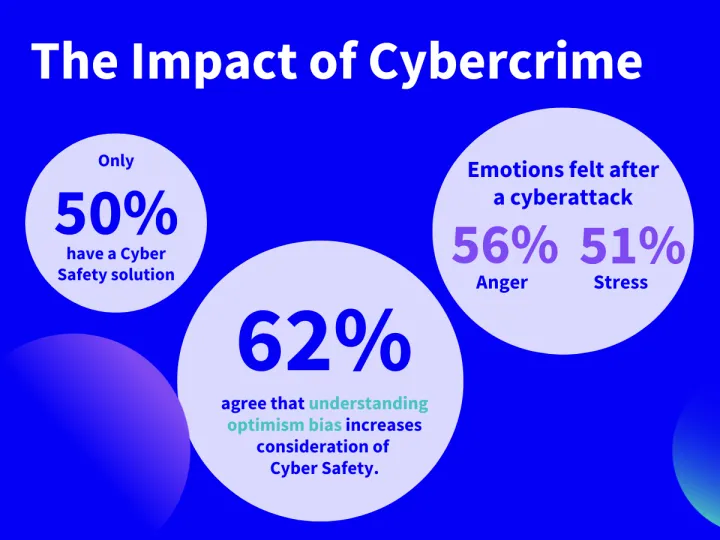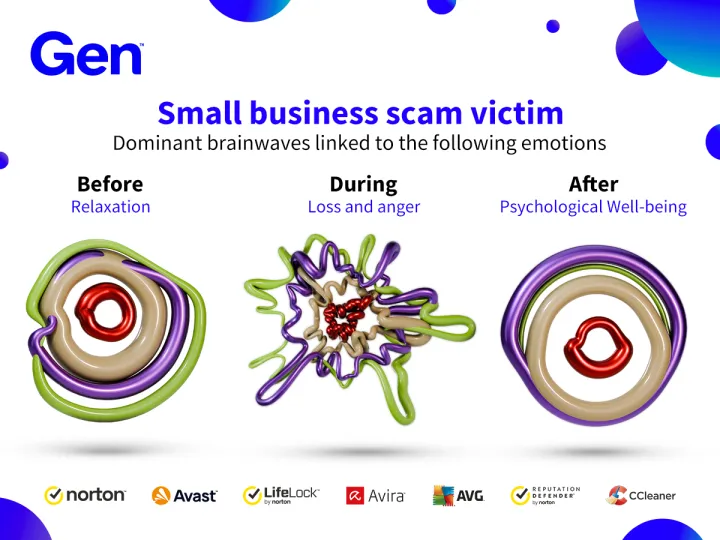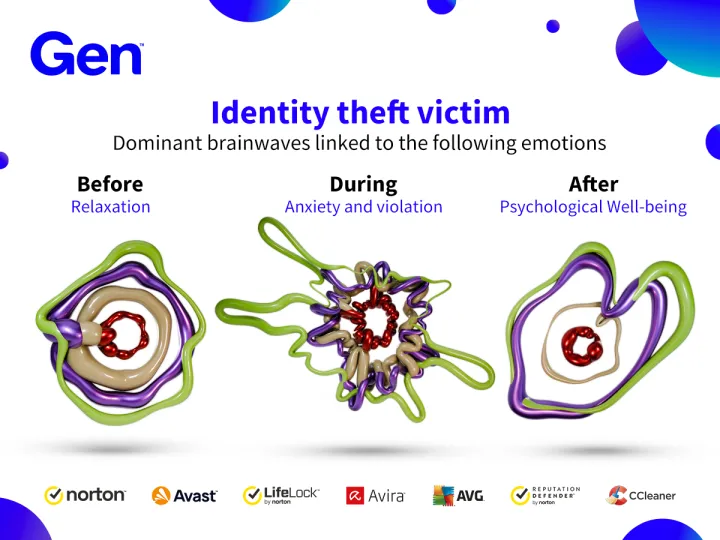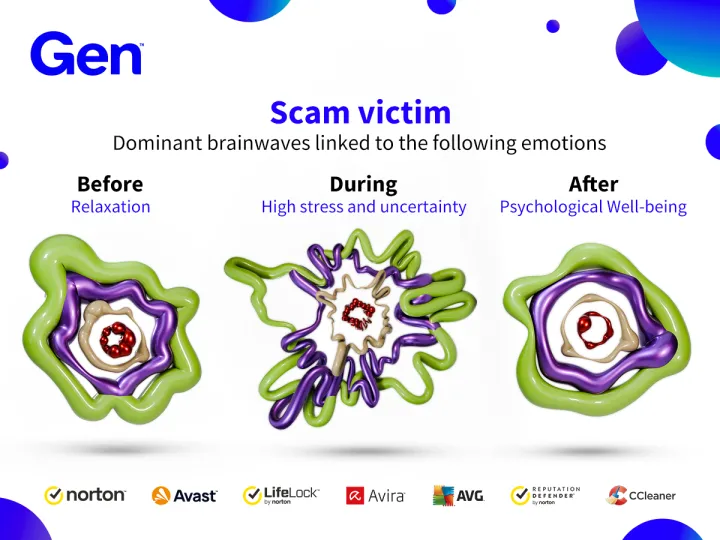Scam Artists: The Impact of Cybercrime


A Gen study reveals that 58% of Americans and British surveyed believed they could be vulnerable to cybercrime.
The truth is, as the nature of technology transforms, so does the advancement of crime. Cybercrimes are more unique and increasingly sophisticated. They range from hacking, phishing, malware and ransomware – all to access, steal or damage sensitive, personal data, disrupt digital systems or extort money. The offenses go on and on. And, still, these crimes differ in techniques, discovery times and victims.
But the reality is this: you're probably already at risk.
With company breaches happening more frequently, hackers breaking into private accounts and even message scams, cybercrime is no longer the distant threat it once was.
Nearly half of people (45%) think cybercrime won't happen to them, leading to only 50% having any form of cybersecurity installed. Many people who chose not to find Cyber Safety protection ultimately paid the price. We did our research to find out just how costly it was.

Looking at the Psychological Costs of Cybercrime
Crimes of all types leave a lasting scar on their victims. Whether cybercrime or more conventional, the impact cuts deep.
Being the victim of a cyber-attack is a traumatic experience, and will elicit a cognitive, emotional and psychological response. Monitoring an individual’s brain activity has the potential to reveal changes in neural activity. And we wanted to bring those emotions and psychological reactions to life visually.
How? We monitored three victims of cybercrimes with Electroencephalography (EEG) headsets. The headsets look deeper into our brains to demonstrate brain reactions to specific topics, events or experiences.
What was the outcome? Scam artists. The artwork below showcases the emotional reaction to the feeling of a cyberattack. Of the respondents who had suffered a cyberattack, anger and stress were the top two emotions felt – and for obvious reasons.
Revealing Internalized Emotions
Business Scam Victim
The owner of Frank's Remedies, Kyle Frank, faced a phishing scam — one of the most common tactics cybercriminals use. Hackers broke into his PayPal account, threatening his business's financial stability. Read more about Kyle's story on the Norton blog and learn how to protect yourself from similar threats.

Identity Theft Victim
Personal finance expert Lynn Beattie, endured distress when hackers obtained her home address and set up a credit account in her name, ordering over £3,000 worth of merchandise using just her name, address and date of birth. Read more about Lynn's story and learn essential protection measures to keep your identity safe on the Norton LifeLock blog.

Scam Victim
Journalist Moya Crockett, encountered an elaborate scam known as automatic push payment (APP) or impersonation fraud. Scammers contacted her, pretending to be a fraud prevention team, after sending phishing texts to make it seem like her account was compromised. They then drained her account. Read more on the Norton blog to learn the full details of Moya's story and discover how to safeguard yourself and your information.

Despite the differences in the attacks they faced, Kyle, Lynn and Moya all experienced the same emotional turmoil. Not only did they face similar emotions, but their experiences also highlighted how diverse and advanced scams have become, emphasizing that anyone is vulnerable to cyberattacks.
We connected with award-winning psychologist Lee Chambers to shine a light on the inherent human instincts that often result in complacent behavior when it comes to digital safety.
“Overall, we can see that being a victim of a cyber-attack and having information breached resulted in a cognitive, psychological and emotional impact on the participants, and recalling their experience has highlighted suppression and prominence of their brain waves. These effects can potentially be long lasting, especially when the scams are intricate, enduring or have a significant life impact,” said Chambers. “And this is why digital literacy and having the right cyber protection in place can mitigate the risk of facing these scenarios and the emotional load they come with.”
A High Price to Pay
Victims of cybercrime often spend countless hours remediating the damage caused by attacks, including resetting passwords, canceling credit cards and disputing fraudulent charges. This lost time can have significant personal and professional consequences, impacting productivity, relationships and, of course, overall well-being. The psychological and emotional toll on victims is one of the most devastating indirect costs, as exemplified by Kyle, Lynn and Moya's experiences.
“Despite knowing I wasn’t the only victim out there, I felt terribly ashamed. And that shame, combined with the shock of losing my life savings, quickly curdled into something very cold and dark,” said Moya.
Creating Smarter Digital Citizens in The Face of Growing Threats
“Cyber threats today are bigger, more pervasive and more sophisticated than ever before, and they are here to stay,” said Leena Elias, Chief Product Officer. “In fact, during our last fiscal year, Gen blocked more than 14 billion attacks. We’re focused on helping people feel confident engaging with the digital world with our products that protect against evolving and emerging threats.”
Cybercrime is not a static entity; it is constantly evolving, with perpetrators devising increasingly sophisticated methods to exploit vulnerabilities and compromise unsuspecting individuals and organizations. This ever-changing landscape underscores the need for continuous vigilance and adaptation.
Personal responsibility and proactive measures are essential safeguards. Gen considers part of our responsibility in the marketplace is not just to protect consumers, but to inform them as well.
Victims like Kyle, Lynn and Moya highlight the diverse and sophisticated nature of cyber threats. From phishing scams to identity theft and impersonation fraud, these incidents demonstrate that cybercrime can impact anyone.
Blocking Crime on The Global Scale
Cybercrime is a borderless threat, and its consequences transcend national boundaries. Addressing this global challenge requires a shared commitment to improving cybersecurity across the globe.
By empowering ourselves with knowledge, adopting secure practices and investing in cutting-edge solutions, we can create a more secure digital world and mitigate the devastating impact of cybercrime on our lives and economies. Together, we can make a difference and protect individuals like Moya, Lynn and Kyle from falling victim to these threats.
Sources
The data presented derived from surveys conducted among Americans and Britons, combining results from a UK sample size of 2,000 with a US sample size of 1,000.